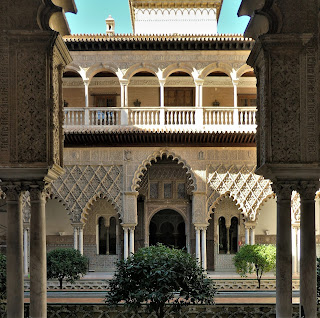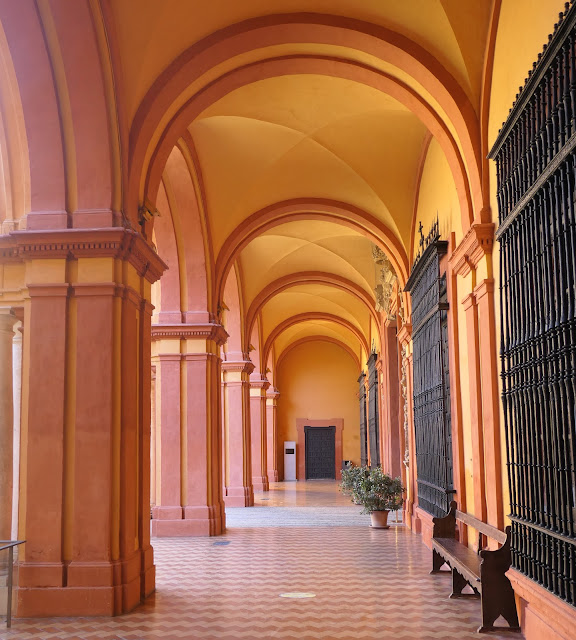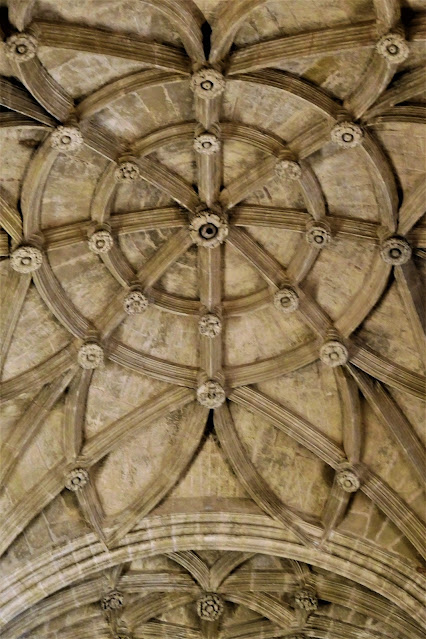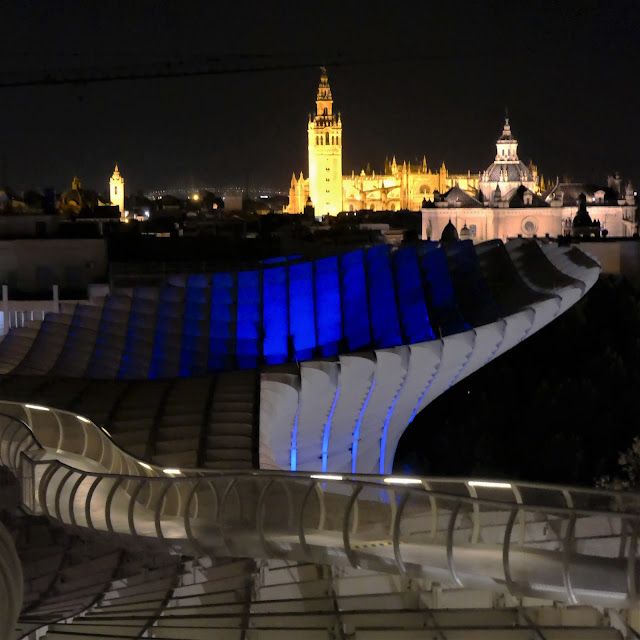In this unusual year, however, tourism has been reduced to a trickle. As a result, the experience - not to mention the extraordinary buildings - is quite a special one. In the last week of October, I walked and taxied back and forth across the city, almost alone in my pursuit of these and other monuments and the city at large. Hundreds of photos later, I saw I had a story to tell first about just four places.
What follows is that: a visual story - with a bit more text than usual - about two of the World Heritage sites and two other places that, undoubtedly, will become a Heritage site in give or take fifty years.
"Outstanding Universal Value"
Brief synthesis
Together the Cathedral, Alcázar and Archivo de Indias as a series, form a remarkable monumental complex in the heart of Seville. They perfectly epitomize the Spanish "Golden Age", incorporating vestiges of Islamic culture, centuries of ecclesiastical power, royal sovereignty and the trading power that Spain acquired through its colonies in the New World.
Founded in 1403 on the site of a former mosque, the Cathedral, built in Gothic and Renaissance style, covers seven centuries of history. With its five naves it is the largest Gothic building in Europe. Its bell tower, the Giralda, was the former minaret of the mosque, a masterpiece of Almohad architecture and now is important example of the cultural syncretism thanks to the top section of the tower, designed in the Renaissance period by Hernán Ruiz. Its "chapter house" is the first known example of the use of the elliptical floor plan in the western world. Ever since its creation, the Cathedral has continued to be used for religious purposes.
The original nucleus of the Alcázar was constructed in the 10th century as the palace of the Moslem governor, and is used even today as the Spanish royal family's residence in this city, thereby retaining the same purpose for which it was originally intended: as a residence of monarchs and heads of state. Built and rebuilt from the early Middle Ages right up to our times, it consists of a group of palatial buildings and extensive gardens. The Alcázar embraces a rare compendium of cultures where areas of the original Almohad palace - such as the "Patio del Yeso" or the "Jardines del Crucero" - coexist with the Palacio de Pedro I representing Spanish Mudejar art, together with other constructions displaying every cultural style from the Renaissance to the Neoclassical.
Authenticity
Each of the three buildings reflects clearly its architectural histories and convey their roles in the Spanish "Golden Age" in terms of ecclesiastical power royal sovereignty and the trading power that Spain acquired through its colonies in the New World.
(https://whc.unesco.org/en/list/383/)
Real Alcázar de Sevilla
The buildings feature and interesting mixture of Islamic, Mudéjar, Gothic and Renaissance architectural styles – the result of the Alcazar’s evolution throughout the centuries. The palaces are surrounded by the marvelous Murillo Gardens where the scent of roses and orange trees waft through the air.
The Alcazar’s history began in the 10th century when the Muslim Umayyad dynasty built a fortress (alcazaba) with a palace (al-qasr or alcazar) and a fortified wall. In the 11th and 12th centuries the Abbadid and Almohad dynasties expanded the fortifications. However, in 1248 the fortifications were not enough to keep out the Christian army who reconquered Seville.
A few years later, King Alfonso X ordered the construction of a gothic palace, part of which is still used today as the official residence of the king in the city. It is the oldest royal palace still in use in all of Europe.
In 1356, Seville was struck by a large earthquake that damaged much of the city and left some of the Alcazar in a bad state. King Peter I (Peter the Cruel) had three Almohad palaces demolished and then set out to build his own lavish abode. His Palacio del Rey Don Pedro was constructed with Moorish workers mimicking their own Muslim style but also incorporating some elements of western Christianity.
Catedral
(https://en.wikipedia.org/wiki/Seville_Cathedral)
(https://en.wikipedia.org/wiki/Seville_Cathedral)
Plaza de España
Designed by Aníbal González, it was a principal building built on the Park's edge to showcase Spain's industry and technology exhibits. The Plaza de Espana complex is a huge half-circle; the buildings are accessible by four bridges over the moat, which represent the ancient kingdoms of Spain. In the centre is the Vicente Traver fountain. Many tiled alcoves were built around the plaza, each representing a different province of Spain
Today the buildings of the Plaza de España have been renovated and adapted for use as offices for government agencies. The central government departments, with sensitive adaptive redesign, are located within it.
....
From 2007 to 2010, the Seville City Council invested 9 million euros in the restoration of the Plaza de España. The objective was to recover the original monument as the architect, Aníbal González, conceived it. To restore it, the restoration team worked to recover pieces such as the ceramic streetlights, benches, and even pavements. In other cases, they created reproductions of elements based on photographs and postcards from the municipal newspaper library.
(https://en.wikipedia.org/wiki/Plaza_de_Espa%C3%B1a,_Seville)
A note on the scale of the place: It is enormous. Just to give you a sense, the structure measures nearly 46,000 m2 (495,00 sq. ft.). The canal itself that curves around the front of this megalith and its plaza is 515m (1670 ft.) in length. That is approximately the length of 5.5 (American) football fields.
This is clearly one f**king tour-de-force of architectural sculpture that can be found on the face of the earth. In terms of place-making, it also clearly rivals some of the most historic built sites – both ancient and more modern - around the world. That it should have found a home in only the fourth largest city in Spain is somewhat inexplicable. It is also a mess in terms of program and layout.
All
of this can almost be forgiven for the glorious juxtaposition of the giant
sculpture against the backdrop of an otherwise typical European square, but
more importantly, for the roof-top experience.
It is part playground, part urban history lesson, part, an almost ethereal
sense of walking in the sky that is reinforced by its undulating path and its
positioning above the surrounding roof lines.
For me, it was a truly unique architectural experience – and you know
that is saying a lot coming from me.






































































































